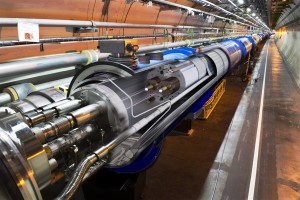Science Seen Physicist and Time One author Colin Gillespie helps you understand your world.
A Particular Success
— For Bill Rachinger, sine quo nihil . . .
CERN’s Large Hadron Collider or LHC is back in the news. And behind the scenes there is fine physics that is little-known.
It is the world’s biggest machine. Liquid-helium-cooled magnets bend twin beams of hydrogen nuclei (aka protons) in a circle. They collide at up to 99.9999% of light-speed. Building this machine has not been easy. Shortly after start-up in 2008, an explosion damaged half a mile of its 17-mile-long cryostat (a very cold refrigerator) and magnets. Repairs took more than a year. For years it ran at less than two-thirds of its design energy. In 2013 it shut down for an upgrade. Now (seven years after start-up) physicists may get to ramp it up to its maximum energy.
Readers of this blog will know I doubt the value of big expensive atom smashers as a physics strategy.  This may seem a double standard. Years ago I built a ‘big expensive’ cryostat to study the cooperation of electrons in superconductors. (When cold, superconductors carry electricity with no loss of energy). On today’s ‘big expensive’ scale my cryostat was tiny and its cost was chump change. But my years of work on it provide a personal perspective on the LHC. Whatever I may think of physics strategy, I admire the work of those who built the LHC and those who are now bringing it into full operation.
This may seem a double standard. Years ago I built a ‘big expensive’ cryostat to study the cooperation of electrons in superconductors. (When cold, superconductors carry electricity with no loss of energy). On today’s ‘big expensive’ scale my cryostat was tiny and its cost was chump change. But my years of work on it provide a personal perspective on the LHC. Whatever I may think of physics strategy, I admire the work of those who built the LHC and those who are now bringing it into full operation.
Theirs is an amazing but mostly unsung achievement. Physics research is competitive. Add to this that competition for post-LHC positions is already brutal. And, even in easy circumstances, managing physicists is like herding cats. Yet, like members of a well-conducted orchestra, thousands of them are playing their parts in an intricate cooperation. A note at the end of an early paper on LHC design gives us a glimpse of this accomplishment:
ACKNOWLEDGEMENTS Cryogenics for the LHC rallies the dedicated work of many colleagues at CERN, as well as in national laboratories and industries in Europe, a few of whom appear as authors in the list of references.
Cryogenics is key because the LHC is a huge cryostat. Its low temperature allows two kinds of quantum cooperation. First there are the liquid-helium-cooled magnets that bend the beam into a circle. Electric current in superconducting wires creates their strong magnetic fields. These fields contain a huge amount of energy. While the wire is superconducting, the energy stays in the field and the current generates no heat. At a few degrees K (i.e., above absolute zero), the current’s electrons move in pairs, this makes them behave like bosons (with integer, rather than half-integer, spin), and bosons love to cooperate. Gazillions of these electron pairs circle through the magnets in unison, in a single quantum state. But if a tiny bit of wire warms up a few degrees it suddenly develops a resistance. The electron pairs split up and dump their energy into the wire. This caused the 2008 explosion.
Here is where the second kind of cooperation comes in. It is a quantum refrigerator. It uses liquid helium at 1.9 K. Helium atoms are bosons. At this temperature the liquid helium is superfluid. It flows with no resistance—at the speed of sound—to any spot that’s even slightly warmer. So superfluid helium is the perfect refrigerant. How this happens is that, like those superconducting electrons, the helium atoms cooperate in a single quantum state.
We tend to picture quantum states in terms of photons or of atoms, creatures of a submicroscopic single-particular world. Yet in the LHC we see not merely macroscopic but huge quantum states built out of vast numbers of particles whose strange cooperation scientists still strive to understand. And I would like to understand the strange cooperation of all those scientists who build and run the LHC.
Sources:
Philippe Lebrun (1994), “Superfluid Helium Cryogenics for the Large Hadron Collider Project at CERN”, European Organization for Nuclear Research, p.5; https://cdsweb.cern.ch/record/266586/files/P00024691.pdf
Other Materials:
Cian O’Luanaigh (2015), “Proton beams are back in the LHC”, 7 April, http://home.web.cern.ch/about/updates/2015/04/proton-beams-are-back-lhc
Colin Gillespie (2013), Time One: Discover How the Universe Began, New York: RosettaBooks, p. 18, http://www.rosettabooks.com/book/time-one/; “The Sinecure”, http://www.timeone.ca/chapters/the-sinecure.pdf
Image credits:
University of Birmingham, Discovering Particles: Fundamental Building Blocks of the Universe, http://www.ep.ph.bham.ac.uk/DiscoveringParticles/lhc/collider/

No comments yet.